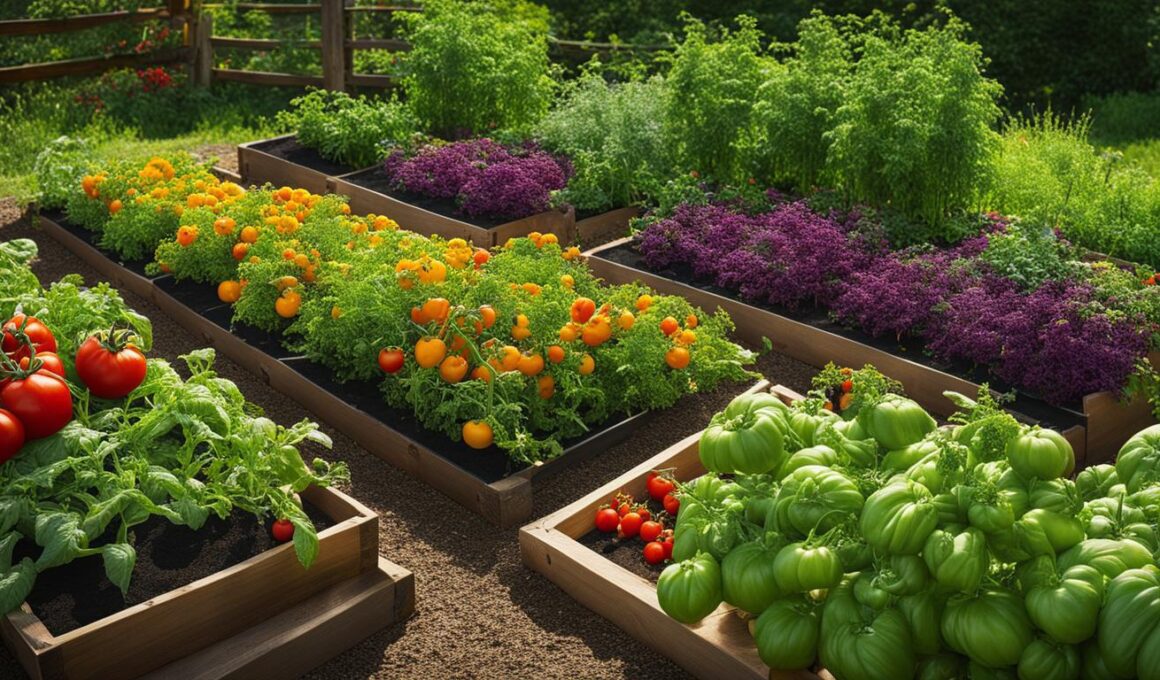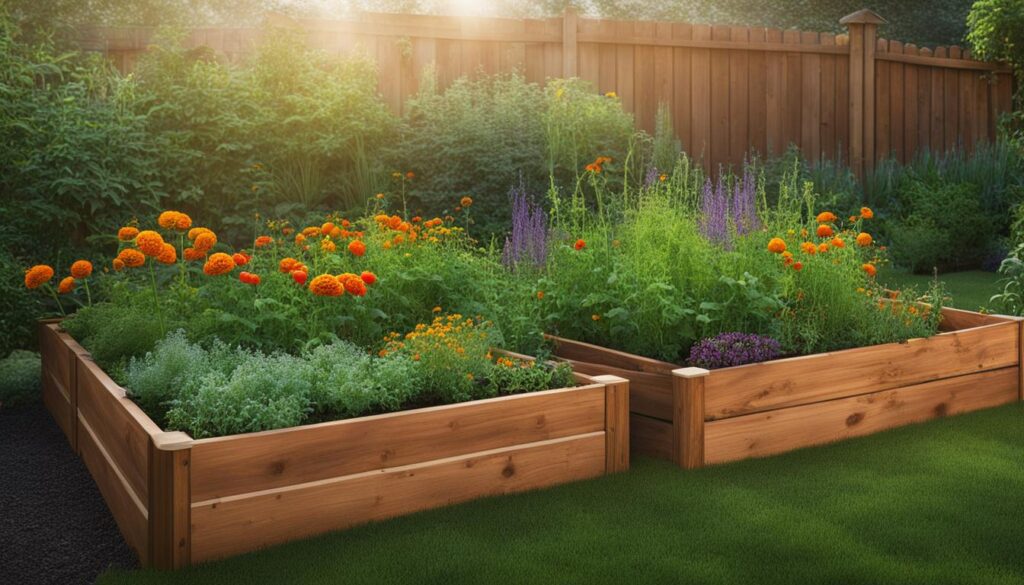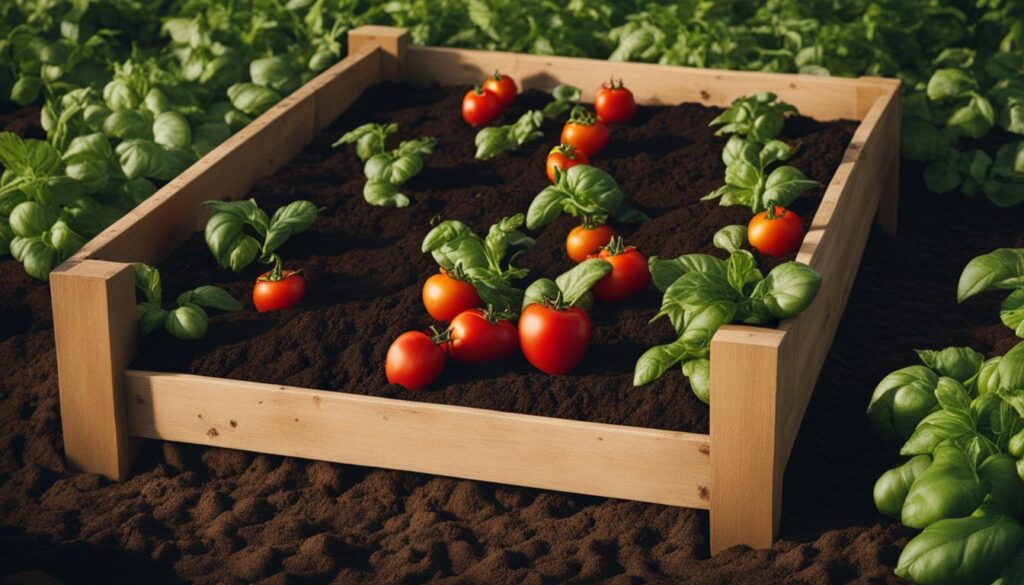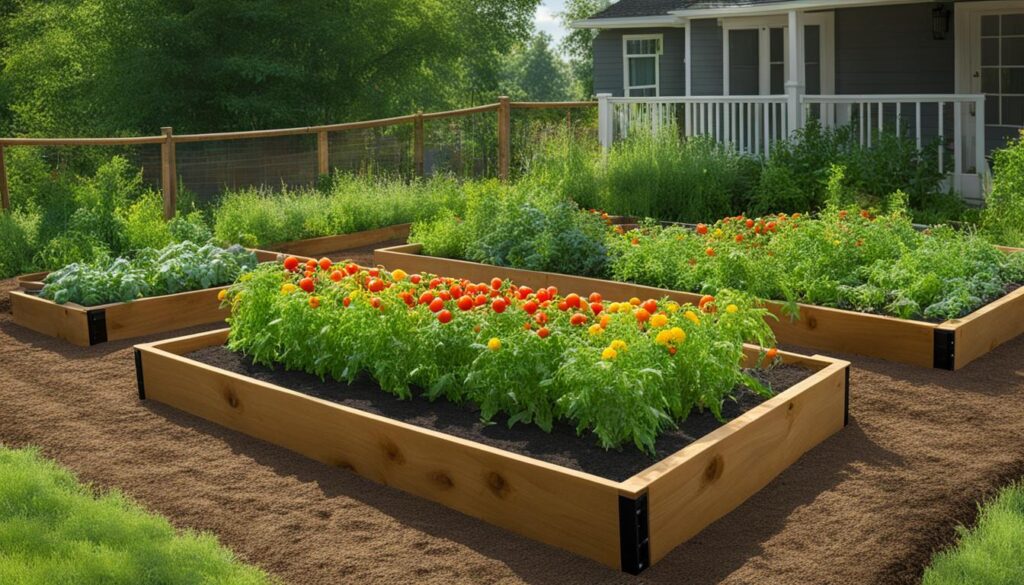Growing tomatoes is a favorite pastime for many home gardeners due to their ease of growth and delicious fruit. To maximize your garden’s yield, it is essential to carefully select the plants that will surround your tomatoes, known as companion planting. Companion planting not only boosts optimal tomato growth but also enhances soil enrichment, root diversification, as well as pest and disease management in your raised bed garden. This guide aims to provide you with valuable insights into the most beneficial plants to grow alongside your tomatoes while highlighting which neighbors may cause harm and should be avoided.
Post Summary
- Companion planting is a strategic approach that fosters symbiotic relationships between plant species.
- Tomato health and yield can be maximized in raised bed gardening through proper companion planting.
- Herbs like basil and chives, vegetables such as asparagus and lettuce, and flowers like marigolds are great companions for tomatoes.
- Avoid planting tomatoes in close proximity to brassicas, fennel, dill, potatoes, eggplants, and under walnut trees.
- Consider spacing, planting depth, and optimal garden layout when incorporating companion plants in your raised bed garden.
Understanding Companion Planting for Tomatoes
Companion planting is a strategic approach that enhances tomato plant health and yield by co-locating compatible plant species. This method leverages the natural advantages of certain herbs, vegetables, and flowers to fend off common pests, improve soil fertility, and facilitate better growth conditions through a symbiotic relationship in the garden ecosystem. It helps gardeners to avoid planting vegetable enemies of tomatoes, such as those with similar nutrient needs or those prone to the same diseases, ensuring productive and disease-free tomato plants.
Benefits of Companion Planting
- Pest prevention
- Soil nutrient management
- Improved plant health and yield
- Natural solutions to common garden problems
By understanding the symbiotic relationships between plants, you can optimize your tomato garden care through companion planting. This method aids in pest prevention, soil nutrient management, and overall plant health for a thriving garden.
| Companion Plant | Benefit |
|---|---|
| Basil | Deters pests and may enhance tomato flavor |
| Chives | Repels aphids and enhances soil fertility |
| Lettuce | Acts as ground cover to maintain soil moisture and suppress weeds |
| Marigolds | Repels detrimental nematodes and pests |
By leveraging the benefits of companion planting, you can create a more resilient and productive tomato garden. This sustainable approach to garden care allows you to harness natural processes in the garden ecosystem, resulting in a healthier, more robust garden.
Top Companion Plants to Enhance Tomato Growth
Companion planting is a powerful technique for promoting garden biodiversity and creating symbiotic plant relationships that lead to healthier tomatoes. By selecting the right mix of herbs, vegetables, and flowers as tomato companions, you can achieve natural pest deterrence, fungal protection, and healthier soil. In this section, we will discuss the top herbal, vegetable, and floral companions to boost your tomato plants’ growth, reduce the need for chemical pesticides, and create a visually appealing garden.
Boosting Tomato Health with Herbal Companions
Herbs like basil, chives, and parsley are excellent herbal companions for tomatoes, offering a range of benefits from pest deterrence to enhanced flavor. Using different herbs in the garden helps to improve the soil health and attract beneficial insects while warding off unwanted pests. Here are some top herbal options:
- Basil: Known for potentially improving the flavor of tomatoes, basil also provides organic pest control through its strong aroma, which deters pests like aphids and whiteflies.
- Chives: These alliums help deter aphids and other harmful insects, and some gardeners believe their growth can increase tomato yield.
- Parsley: A good companion plant for tomatoes, parsley attracts hoverflies, which are beneficial pollen-eating insects that help control aphids.
Vegetable Allies: What Veggies to Grow Alongside Tomatoes
Vegetables offer a unique set of benefits as tomato companions, such as nutrient sharing and efficient garden space utilization. Here are some top vegetable companions to grow with your tomatoes:
- Asparagus: A fantastic companion plant for tomatoes, asparagus helps repel pests like the asparagus beetle, while tomatoes protect asparagus from aphids.
- Lettuce: Lettuce helps maintain soil moisture and suppresses weed growth, acting as a natural ground cover in your tomato garden.
- Garlic: This pungent plant wards off pests with its strong aroma, promoting natural fungal protection and potentially enhancing tomato plant health.
Utilizing Flowers for a Pest-Resistant Tomato Bed
Flowers enhance your garden’s visual appeal while acting as natural pest deterrents and pollinator attractants. Including companion flowers for tomatoes in your garden can significantly reduce the need for chemical pesticides. Here are some flowers that make excellent tomato companions:
- Marigolds: Known for their ability to repel detrimental nematodes and pests, marigolds help protect your tomato plants and enhance their growth.
- Petunias: These beautiful flowers are an effective pest deterrent, keeping away aphids, tomato hornworms, and other harmful insects.
- Nasturtiums: These vibrant flowers not only add color to your garden but also repel aphids and whiteflies, contributing to a pest-resistant tomato bed.
By incorporating a diverse mix of herbs, vegetables, and flowers as companions in your tomato garden, you can create a harmonious garden ecosystem that promotes healthy plant growth and maximizes yield. With these companion planting strategies, your raised bed tomato garden will thrive organically, attracting pollinators and effectively deterring pests without the need for harmful chemicals.
Mistakes to Avoid: What Not to Plant with Tomatoes
While companion planting holds numerous benefits, there are certain plants that, when grown near tomatoes, can lead to harmful plant combinations, resulting in nutrient competition, shared pests and diseases, and decreased productivity. Careful garden planning is essential to ensure the harmonious coexistence of plants in raised beds. Knowing which plants to avoid can help to mitigate undesirable effects on tomato growth and overall garden health.
- Brassicas: Plants in the brassica family, such as cabbage and broccoli, should not be grown near tomatoes, as they have different nutrient requirements and may compete for resources.
- Nightshades: Other plants from the nightshade family, including potatoes and eggplants, can harbor shared pests and diseases, making them poor companions for tomatoes.
- Mature Dill: Mature dill plants can have a negative impact on tomato growth and should therefore be planted away from tomato plants. However, young dill plants can be a good companion for tomatoes.
- Corn: Planting tomatoes too close to corn can increase the risk of both plants being attacked by shared pests, such as tomato fruitworms and corn earworms. To avoid this double threat, it’s best to keep them separate.
By keeping incompatible plants away from your tomatoes, you can streamline your gardening efforts and contribute to a more successful garden. Here is a table summarizing the key plants to avoid:
| Plant | Reason to Avoid |
|---|---|
| Brassicas (cabbage, broccoli) | Nutrient competition |
| Nightshades (potatoes, eggplants) | Shared pests and diseases |
| Mature dill | Negative impact on tomato growth |
| Corn | Shared pests |
In conclusion, when planning your tomato garden, it is crucial to be mindful of the plant combinations you choose. By avoiding incompatible plants and optimizing companion planting, your garden will flourish, providing you with a bountiful harvest of ripe, juicy tomatoes.
Maximizing Harvest: Strategic Layout in Raised Beds
For a thriving tomato garden, it’s critical to adopt a strategic layout in raised beds where companion planting can be effectively implemented. A well-planned raised bed layout allows you to create tomato planting techniques that maximize harvests in small spaces. Two essential factors to consider are optimal plant spacing and planting depth, which both play significant roles in preventing diseases and promoting healthy root development.
Spacing and Planting Depth Considerations
Adequate distances between tomato plants are vital to prevent the spread of diseases like blight and promote strong root development. Proper planting depth ensures that the plants establish their roots effectively. The following guidelines will help you utilize raised bed space efficiently to optimize sunlight exposure, soil moisture, and airflow for a generous tomato harvest:
- Spacing for Tomato Plants: To ensure healthy growth and optimal yield, plant tomatoes at least 24-36 inches apart, with rows at least 36-48 inches apart.
- Depth: Plant tomatoes at a depth of at least 6-8 inches to establish a strong root system. If you’re using indeterminate tomato varieties, consider planting them deeper (up to their first set of true leaves) to encourage more vigorous root development.
- Planting Companion Plants: Position companion plants near the tomatoes without encroaching on their essential space requirements. By doing so, you can still enjoy the benefits of companion planting while ensuring that your tomatoes have adequate room to grow and thrive.
To further illustrate the optimal plant spacing and planting depths, consider this sample layout of a raised bed tomato garden:
| Plant Type | Optimal Spacing (in inches) | Planting Depth (in inches) |
|---|---|---|
| Tomatoes | 24-36 | 6-8 |
| Basil | 12-18 | 1/4 |
| Chives | 6-12 | 1/4 |
| Lettuce | 6-12 | 1/4-1/2 |
| Marigolds | 8-10 | 1/4 |
By implementing these guidelines in your raised bed tomato garden, you can take advantage of a strategic layout to maximize yield, maintain healthy plants, and create a visually pleasing garden space.
Can the Fall Vegetables Mentioned in the Second Topic Be Planted Alongside Tomatoes in Raised Beds?
Yes, fall vegetable growing pots can be planted alongside tomatoes in raised beds. By carefully choosing companion plants such as carrots, lettuce, and spinach, you can maximize the use of space and soil in your raised beds. This allows for efficient and productive gardening during the fall season.
Conclusion
In summary, successful companion planting is vital for enhanced tomato cultivation within raised bed gardens. By carefully selecting harmonious neighbors, you can foster improved plant health and growth, keeping pests and diseases at bay, and ultimately increasing your garden yield. Organic gardening strategies, such as surrounding your tomatoes with beneficial herbs, vegetables, and flowers, contribute to a flourishing garden ecosystem that supports the health and productivity of your tomato plants.
Understanding potential pitfalls, such as avoiding the cultivation of certain species of brassicas, nightshades, and particular herbs near tomatoes, is essential in preventing competition for nutrients and shared diseases. By paying attention to these need-to-know neighbor rules, you’re taking a significant step in safeguarding your crop from potential dangers.
Lastly, implementing strategic garden layout practices in your raised beds ensures an optimal environment for tomato cultivation, complete with proper plant spacing and depth considerations. Keeping these tips in mind will contribute to a thriving and bountiful tomato harvest that you can enjoy throughout the season, successfully savoring the fruits of your efforts in your raised bed garden.











